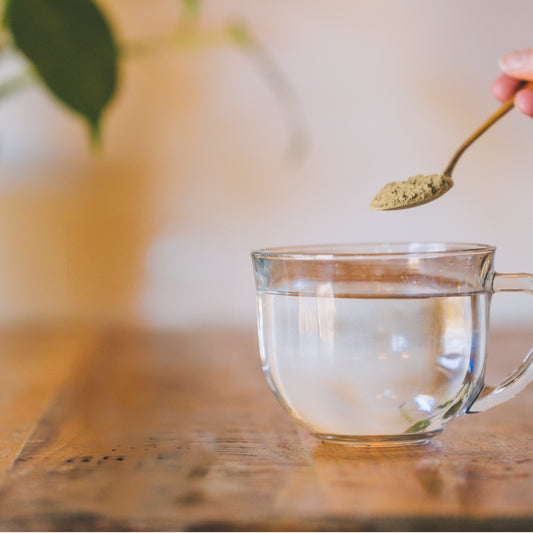Triphala is a quintessential Ayurvedic herbal formula that has been widely used for thousands of years.1 A powerful blend of three fruits—amla, bibhitaki, and haritaki—it contains an abundance of antioxidants and phytochemicals that are supportive of excellent health throughout the entire body.
Triphala is non-habit forming and known for its incredible detoxifying and rejuvenating qualities.
Triphala is commonly found in powder, tablet, or liquid extract form and is also found combined with a multitude of other herbs in formulations used to target specific imbalances.
Let’s explore some of its most popular uses and myriad health benefits.
Top 10 Benefits of Triphala
1. Supports Digestive Health
Triphala is best known as a gentle GI tonic. Through its synergistic effects, it supports a healthy gut microbiome,2 promotes regular elimination3, relieves occasional constipation, and reduces intestinal discomfort, all while improving digestion and absorption of essential nutrients.4
As Ayurveda believes that poor digestion is the root cause of all imbalance, triphala is a great formula to use to cultivate a foundation of overall well-being.
2. Supports Natural Detoxification
Triphala is unique in that it promotes natural cleansing while at the same time rejuvenating all the tissues in the body. It helps flush natural toxins by supporting the healthy functions of the GI tract, the liver, and the kidneys, and it promotes cleansing at a cellular level.5
Less waste leads to better wellness by creating less stress on your system.
3. Supports Healthy Weight Management
Studies have also shown that triphala supports healthy weight management and helps to balance blood sugar levels, which in turn supports a healthy appetite.6 In addition, by providing five of the six tastes—sweet, bitter, sour, pungent, and astringent—triphala reduces unhealthy cravings and supports healthy digestion, elimination, and metabolism.
4. Supports a Healthy Immune System
Studies have shown that triphala’s natural abundance of antioxidants protects cells from damage by reducing oxidative stress and strengthening the body’s defense against the development of imbalance and chronic ailments.7,8
Triphala has positive effects on the gut microbiome (which is intimately connected to our immune system) and helps regulate both the inflammatory and immune response.
In addition, the ingredient amla is known to be a natural source of vitamin C, further contributing to healthy immune function.
5. Supports a Healthy Inflammatory Response
Triphala’s abundance of antioxidants, vitamin C, polyphenols, and flavonoids significantly supports a healthy inflammatory response in the body.9 This in turn supports healthy tissues and diminishes the risk of developing imbalances throughout the system.
6. Supports Stress Reduction
By improving the gut microbiome, triphala helps to improve overall well-being and reduce feelings of anxiousness and sadness10 while simultaneously promoting a sense of calm.
Triphala also supports balanced and restful sleep11 while increasing energy and helping to deal with everyday stresses with greater equanimity.
7. Supports Heart Health
Triphala supports the cardiovascular system by balancing cholesterol and blood pressure levels already in the normal range.12 A strong digestive system and a regulated immune response also contribute to a healthy cardiovascular system.
8. Supports Eye Health
Due to its natural abundance of antioxidants, as well as its make up of flavonoids, polyphenols, and other bioactive compounds,
Triphala has been traditionally used in
9. Supports Oral Health
Triphala’s detoxifying properties contribute to its benefits for overall oral health.14 It has traditionally been used as in natural toothpastes, mouthwashes, and pulling oils, helping to remove excess toxins and bacteria and leading to fresher breath.
10. Supports Graceful Aging
Triphala is a rasayana that balances the three doshas and nourishes all of the tissues, in turn supporting longevity and healthy aging. Its natural antioxidant action neutralizes free radicals and helps to protect cells from damage15 while reducing the risk of imbalance.
The Ayurvedic sage Charaka wrote that “taking Triphala Rasayana helps a person live for 100 years free from senility and disease.” 16

How to Use Triphala
As one of Ayurveda’s most popular and commonly recommended formulas, triphala has been used in a myriad of ways for thousands of years. When you begin taking triphala it may taste very bitter, but the taste will change as your health improves.17
The formula is traditionally taken as a powder, but if you are sensitive to taste you may prefer to take it as a tablet at first.
Take it as a Powder
To support natural elimination, add 1/4 to 1/2 teaspoon triphala powder to warm water and let it sit for at least ten minutes. Either strain the liquid or leave the dregs in the bottom of the cup and take in the morning or evening on an empty stomach.18
Take Triphala Tablets
Tablets provide a quick and convenient way to receive the benefits of herbs. They are also a great option for those sensitive to taste, as they can be easily swallowed. As a part of your daily wellness habits, take one to four Triphala tablets at bedtime or in the morning on an empty stomach.
Try Charaka's Triphala Rasayana Recipe
To make a rejuvenating tonic that nourishes and supports healthy tissues, mix 1/4–1/2 teaspoon of triphala powder with a teaspoon each of ghee and honey. Take it in the morning before food.19
General Guidance
Triphala is generally safe for most people to use. Because it has a downward moving action in the body, do not take triphala if you are pregnant, menstruating, or if you have loose stools. On occasion, some may experience a bit of digestive discomfort at the beginning, but these symptoms usually dissipate quickly.
As when starting any new supplement, or if you are on medications, check with your health professional before introducing triphala to your routine. Then pay careful attention to how you feel: our body’s needs fluctuate day to day, and the more we learn to listen, the more it will let us know what works best for us!
Triphala is a powerful yet gentle herbal formula with many benefits that can significantly affect your well-being and help you to lead a long and healthy life.










